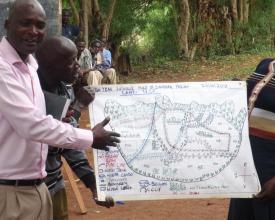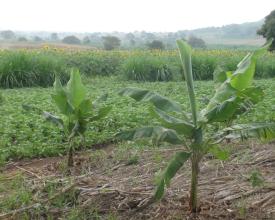
Using a participatory and experiential learning approach to incentivize and increase the adoption of Ecosystem-based Adaptation (EbA) measures in Eastern Uganda

Sanzara parish is located in the lower region of Kapchorwa district, bordering the dry Karamoja region. The parish lies in the rain shadow of Mt. Elgon, exposing it to both prolonged drought and increased flooding due to changing precipitation patterns. These conditions, coupled with a growing population, have affected the agricultural potential of the area, causing chronic food insecurity and abject poverty. In many cases, communities struggle for basic survival, as demonstrated by the high rate of ecosystem degradation and the slow uptake of ecosystem restoration interventions. This solution is about incentivizing adoption of EbA measures in Sanzara Parish. It is based on a case study from the Flagship Mountain EbA project, which was implemented on Mt. Elgon from 2011 to 2015. Lessons from this project are the basis for work done under the follow-on project, “Scaling up Mountain EbA project; building evidence, replication of success and informing policy” within the same landscape.
Contexto
Défis à relever
Sanzara Parish is extremely vulnerable to the impacts of climate change due to high levels of poverty and continuous population growth. Some of the identified impacts of climate change at this site include prolonged droughts, flooding, and soil erosion. Community members depend mostly on agriculture for their livelihoods. However, due to the high population in the Mt. Elgon region, land pressure and ecosystem degradation are a central challenge for the sustainable development of the region. Some of the challenges this solution addresses are:
Environmental: Water stress, pollution of rivers, flooding, drought, soil erosion, and land degradation.
Social: Low adoption rates of EbA measures due to the extreme vulnerability of the community, poor social cohesion and organization, and ethnic and land conflicts.
Economic: Extremely low levels of household income, limited livelihood options, high costs of knowledge transfer, and a widespread lack of money management skills.
Ubicación
Procesar
Summary of the process
Building Blocks 1 (BB1), 2 (BB2) and 3 (BB3) interact in several ways:
- BB1 provides the information on key issues and challenges that will be addressed in BB2 and BB3.
- During BB1, the community and other relevant stakeholders work together to identify possible EbA solutions that can be demonstrated in BB2 and included in farm plans in BB3.
- The challenges identified in BB1 help determine the characteristics required for choosing the site for BB2. In other words, the demonstration site (BB2) needs to be representative of the issues identified during BB1.
- Stakeholder mapping during BB1 identifies the resource people who will support the design, implementation, and management of BB2.
- BB2 provides feedback on BB1. The evidence generated and lessons learned during BB2 contribute to the evaluation of BB1. BB2 provides an opportunity to analyze whether the correct approaches, processes, and tools were used during BB1.
BB2 provides the knowledge and skills that are applied on farms in BB3.
Building Blocks
PARTICIPATORY COMMUNITY DIAGNOSTIC AND PLANNING
The purpose of this building block is to work with the affected community to identify the major problems and underlying causes using participatory tools. In Sanzara, the process started with a vulnerability impact assessment that combined both scientific and participatory tools to identify potential climate impacts, rate of ecosystem services depletion, risks, and current adaptation measures. A community map of the most degraded areas in the catchment was developed; based on this, a problem/solution matrix was prepared that provided details about the main climate challenges and impacts, how these affected different categories of people, and a suite of possible restoration and adaptation interventions. This process culminated in a 10-year vision map and a strategy for achieving this vision. Deliberate effort was put into ensuring that mobilization, timing, and organization of meetings encouraged all categories of community members (women, youth, elderly etc.) to actively participate. The process put the community members at the center, thereby promoting ownership of the ensuing vision and strategy. This ownership contributed to a collaborative effort to sustain these interventions with clear action plans and a community-driven monitoring framework.
Enabling factors
- Ensure that the process is as participatory and as interactive as possible.
- Ensure that key community groups such as women, elders, youth, and other vulnerable groups are fairly represented throughout the process.
- Bring on board relevant actors such as local governments, political, cultural, and religious leaders, and civil society organizations.
- Support the strengthening of local governance structures to promote ownership and sustainability of the interventions.
- Align implementation of the measures with the government planning cycle.
Lesson learned
- Building the trust of communities requires long-term engagement and the inclusion of all relevant actors. This is especially important in communities where there is controversy over questions like land tenure.
- Any community will be comprised of individuals with different levels of understanding of and appreciation for the issue at hand. Recognizing these different levels and devising means to ensure that everyone remains on board is key to avoiding cases of maladaptation.
- Participatory planning is crucial for ensuring that all partners, beneficiaries, and stakeholders are engaged in the process right from the start. This builds cohesion and helps ensure ownership and sustainability.
- Managing expectations is critical to ensuring that community members participate for the right reasons. This is key for sustaining behavior change toward the implementation of EbA interventions.
EXPERIENTIAL LEARNING THROUGH AN EBA DEMONSTRATION AND LEARNING CENTER
The purpose of this building block is to enhance knowledge and practical skills related to EbA measures, as well as to accelerate the level of adoption of EbA measures. The community provided a two-acre piece of land on which all the EbA measures were demonstrated. Community members provided all the labor at the demonstration site and Kapchorwa District Local Government staff provided technical support. The evidence generated regarding the effectiveness of the EbA measures at the demonstration site helped to catalyze the uptake of EbA measures on farms. Some of the components of this building block include:
- Identification of a central and accessible piece of land that is representative of the issues that are to be addressed through EbA.
- Practical training on EbA measures through on-site demonstration.
- Preparation of an operation plan for the demonstration site, as well as a governance structure (e.g. Sanzara Landowners Association) to manage the day-to-day activities on the demonstration site.
- Preparation of a business plan for the demonstration site, including a plan for how the proceeds from the demonstration site will be used.
- Training of trainers, who will continue to work with individual farmers over time.
Enabling factors
- Awareness of climate change and its impacts.
- Positive relationships and trust among all stakeholders.
- Willingness of local government partners to leverage resources from other programs and projects.
- Local contributions (material, labor, land) and ownership of interventions.
- Availability of land for a length of time that is sufficient for the impact of EbA measures to be observed.
Availability of ready markets for the produce from the demonstration site, which enables the realization of economic benefits from the EbA measures.
Lesson learned
Lessons learned:
- Having a central demo site reduces the cost of training. Continuously working together at the demo site enhances community cohesion and hence social resilience.
- The location of the demonstration site is key. A site that is accessible during all seasons maximizes farmer training opportunities.
- Demonstration of EbA measures provides an important opportunity for community members to witness benefits first-hand, thereby facilitating attitude change and accelerating adoption. On-farm follow-up and technical support, as well as participatory monitoring and evaluation, are fundamental to sustaining adoption.
Challenges:
- Some people wanted a direct payout of the proceeds from the demo site, rather than the establishment of a community fund for small loans. Some members dropped out of the demonstration activities when it became clear they would not receive payouts.
- Successful demonstration of EbA measures does not guarantee the uptake and continuation of EbA measures on farms. Old habits die hard, and negative peer pressure can undermine efforts.
PROVISION OF INCENTIVES TO CATALYSE COMMUNITY ADOPTION OF EBA MEASURES
The purpose of this building block is to address the immediate needs of an extremely vulnerable community, therefore enabling them to focus their attention on the implementation of EbA measures. The most pressing needs for the Sanzara community were water and livelihood opportunities. In order to address the water scarcity, a gravity flow scheme was constructed on River Sipi to facilitate a stronger understanding of the ecosystem’s value, and to motivate its restoration through EbA measures. The gravity flow scheme was participatorily agreed upon with the community and the Kapchorwa District Local Government. The community provided the labour for its construction, and the District provided the technical expertise.
In addition, a performance-based cash grant incentive scheme was introduced as a way of providing the much-needed cash for meeting day-to-day needs, while also catalysingthe implementation of EbA measures. Households/land owners were supported to develop climate-smart land use plans, depending on the climate change challenges on their land. Cash incentive payments to participating farmers/land owners were then made in 4 equal instalments, based on their compliance and progress in implementing these plans.
Enabling factors
For the performance-based cash grant scheme, the following factors are key:
- Farm-level planning, which culminates in climate-smart land-use plans.
- A comprehensive monitoring system that is able to track implementation progress at the farm level.
- A participatory and transparent mechanism for distributing the cash grants.
- Participatory identification of interventions to address immediate needs. As in the case of the gravity flow scheme, local contributions toward these interventions are essential, as they build ownership and commitment.
Lesson learned
For an incentive scheme to be effective, it should include as many people in the targeted community as possible, without excluding any particular group. In Sanzara, the incentive scheme was introduced as a trial and only targeted 100 people. This created unnecessary tension and distraction, as some people complained about being left out, while others were trying to implement the agreed climate-smart interventions.
Participatory planning is crucial to ensuring that all partners, beneficiaries, and stakeholders are engaged in the process from the very beginning. This builds a sense of ownership for the measures and helps ensure their longevity. The participatory visioning that was undertaken with communities at the onset of the project provided a point of reference for communities to check progress during their annual review meetings. The 10-year vision that was developed (2012 – 2022) continues to be a reference point for communities and other stakeholders.
Impacts
Overall, the solution had a positive impact on the adoption of EbA measures in Sanzara Parish. Over 100,000 trees were planted (with an 80% survival rate as of Dec. 2015), and 3,450 meters of soil and water conservation structures were established to control soil erosion and flood water on farms. Sipi River's water quality improved, with decreases in chemical oxygen demand, turbidity, and nitrates of 39%, 10% and 36%, respectively.
At a social level, community members organized themselves into groups and taskforces to jointly implement the EbA measures. For example, during the construction of the gravity flow scheme (established to address water stress), communities provided free labor, reducing establishment costs by 30%. With improved access to clean water, women and children were spared the dangers associated with traveling long distances to fetch water.
Adoption of soil and water conservation practices improved land productivity and increased yields, which improved food security and household incomes. Action learning revealed that 15% of the community had shifted from the “very poor” category to “average” within two years.
The community provided land on which a demonstration centre was established. This increased the number of adopters, as well as provided the basis for the creation of a revolving fund governed by the community.
Beneficiaries
The measures help the women of Sanzara Parish (pop. 8700) to better provide food and water for their families, offer men more opportunities to increase household income, and reduce the burden/danger of collecting water and firewood for children.
Sustainable Development Goals
Story

Felista Chemusto, better known in the community as “Mama Kelele”, is one of the lead women in the community and a beneficiary of the project. Since the introduction of EbA measures in Sanzara, she has participated actively and mobilized others. She was very welcoming to the project and promoted it strongly, even composing songs to encourage others to participate. Mama Kelele was particularly motivated to adopt the EbA measures because her land was extremely degraded. There were no trees or shrubs, and much of the land around her property (which is near a ridge) was burned regularly to get rid of vermin (baboons, squirrels), to hunt for small wild animals (wild rabbits, antelopes, and edible rats), and to get new pasture for grazing livestock. Because of the burning, her husband had to travel far with their cattle to find pasture. With the introduction of EbA measures, and the incentive scheme, people in her neighborhood stopped burning, and instead planted trees on the ridge and constructed trenches within the river bank. The gravity flow scheme was also an incentive to stop the burning, since there was fear of burning the plastic water pipes. Now that the burning is controlled and EbA measures have been implemented, Mama Kelele’s land has greatly recovered. The trees provide shade, lowering the local temperatures and acting as windbreakers. Mama Kelele appreciates much her trees, especially her mangoes, as they are now producing fruits that she can sell in other towns for extra income. Her son is also actively involved in the EbA measures, and has helped install an irrigation system on the property.
“Before the project, we were full of problems. There was too much wind that came and destroyed peoples’ houses. Now we are seeing some changes since we planted the trees. Strong winds are no longer there. Also, there was too much drought and now this has reduced. Back then we didn’t even know that we could plant vegetables here. Thanks to the trainings, now some people get money from the crops they plant during the dry season, like tomatoes and sukuma wiki (collard greens). (Comments from Mama Kelele during an interview in March 2019).























